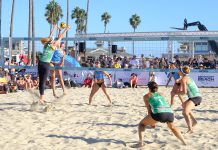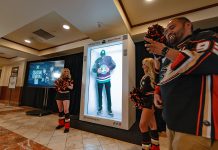Ahoy!
Next Wednesday is a sad note for some boaters as lobster season will end on March 16 in Southern California until next October. I love to eat Panulirus interruptus, but this year I have heard little from recreational divers and fishermen catching the bugs along our coast. So, I am curious if this was a good season or not for a lobster in everyone’s pot?
I am sure that many people from Newport Harbor will be talking about the lobster season next week at the Fred Hall Fishing and Boat Show. The Fred Hall Show is the best fishing tackle and destination travel show in the West and organizers are one of the most spectacular shows in the last 65 years. On display, you will see an expanded selection of hunting, shooting and camping exhibits, and a fantastic selection of fishing boats. The show – at the Long Beach Convention Center – will be the largest powerboat show in California.
Come to the show on Saturday, and join us when my radio show will broadcast live from the Maritime Institute’s booth at noon, Pacific time. Additionally, great events for the whole family are scheduled, such as the Great American Duck Race, Dock Dogs, fly-fishing seminars, and a hunting stage. The show starts on the last day of lobster season, Wednesday, and concludes Sunday evening, so plan on taking a short drive up the coast to visit one of our neighboring harbors.
On another topic while I was cruising Newport Harbor, I heard a few whistle signals that all boaters should understand, but I know many recreational boaters have never taken the time to learn the basic signals. So, I thought I would start providing boater safety information as we begin to draw near to the summer season.
First, let’s start with the nomenclature involved in honking a horn on a boat. This is technically called a whistle signal, and each whistle is a blast either short or prolonged. The blasts have specific meanings, such as the signal of three short blasts. This is a common signal in Newport Harbor, and an important one for avoiding a collision.
Most of the whistle signals in the harbor are given by the commercial Captains such as the dinner boat operators. Commercial skippers have a set of strict rules that they must follow while navigating the harbor, and as such, whistle signals are normal operating procedures.
Let’s focus on the three short blasts in today’s column and I will explain other whistle signals in upcoming columns. Three short blasts signify that my vessel’s propellers are in reverse, but my boat may still have forward momentum. Basically, when I signal with three short blasts then I am telling you that I am either backing down or I have put my transmission in reverse. So, in a crossing situation, I am slowing or stopping to let you cross in front. Additionally, a skipper can signal three short blasts when backing a boat out of its slip.
Regularly in Newport Harbor, I mistakenly hear skippers adding one prolonged blast immediately in front of the three shorts. There should be a one-minute separation between the prolonged blast and the three shorts when backing out of a slip, but more on prolonged blasts in another column.
There are times when I signal three short blasts to another boater in Newport Harbor and that skipper usually signals back with a one-finger salute, completely ignorant that I am being courteous and letting him know my intentions.
Next time someone signals three shorts to let you cross, give them a thank-you wave.
Tip of the week is do you know you can read the actual ocean conditions on the Internet from numerous weather buoys floating out in the ocean? There are a few different sites with different formats that post the buoys’ information that hourly. The information includes wave height, wave direction, wave periods, wind speed and direction, wind gusts, and water and air temperatures. There are graphs of the past few days that help you predict if the conditions are increasing or decreasing.
The buoy information is being used for wave modeling forecasts, and I use the buoys daily to track the conditions. My favorite is www.lajollasurf.org/buoylist.html where you can select the West Coast, East Coast or the Gulf Coast to see current conditions, and it is always interesting to see what the conditions are around the nation’s coastlines.
And don’t forget: Tune in to the No. 1 boating radio talk show in the nation, Capt. Mike Whitehead’s Boathouse Radio Show, broadcasting coast-to-coast on the CRN Digital Talk Radio syndicated network every Saturday at noon, Pacific Time and replayed on Sunday at 10 am Pacific. Join Chandler Bell and me as we talk about “all things boating.” You can find the station listings, cable TV channels, live streaming on the Internet, and now available are apps to listen to the show for your iPhone, Blackberry, iTouch, Android, Palm, and Windows Mobile at www.BoathouseTV.com or www.BoathouseRadio.com.
Until next week, Safe Voyages!




